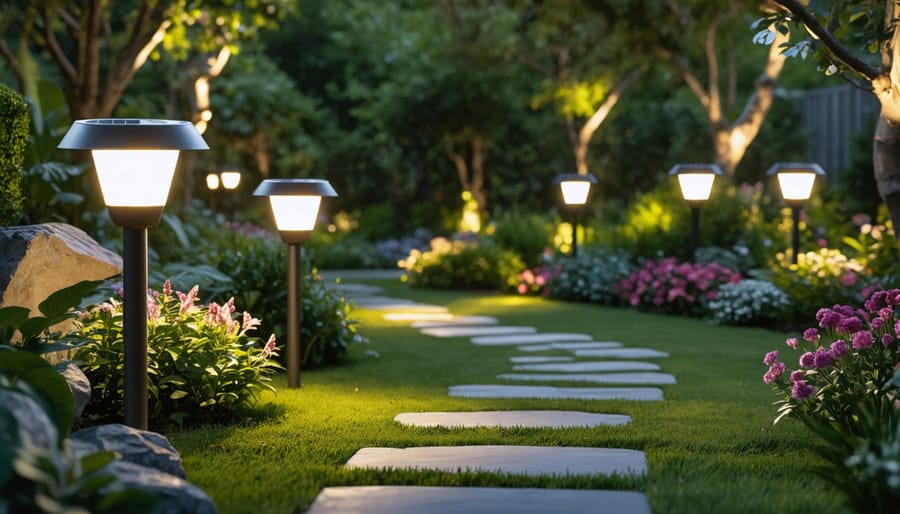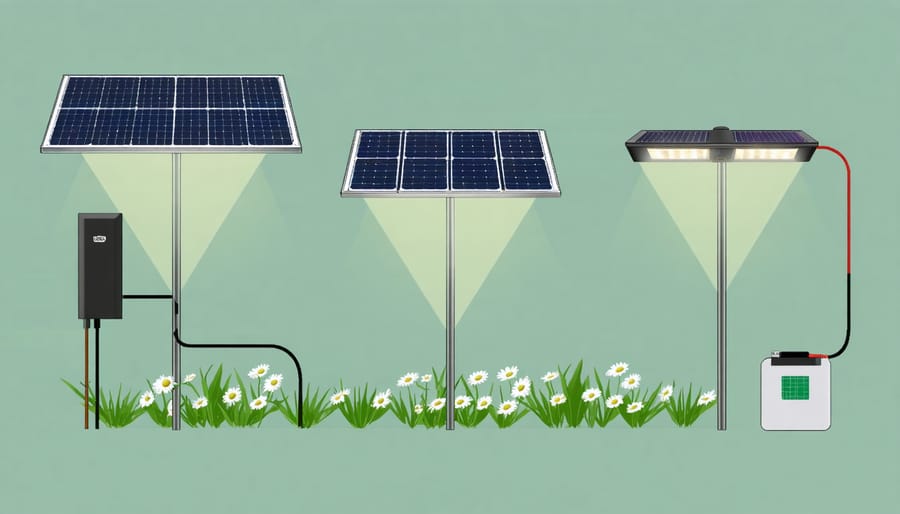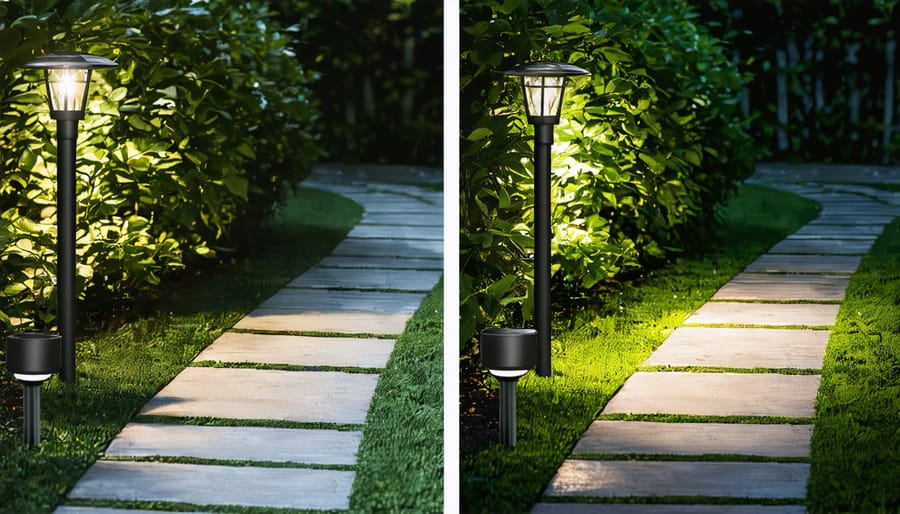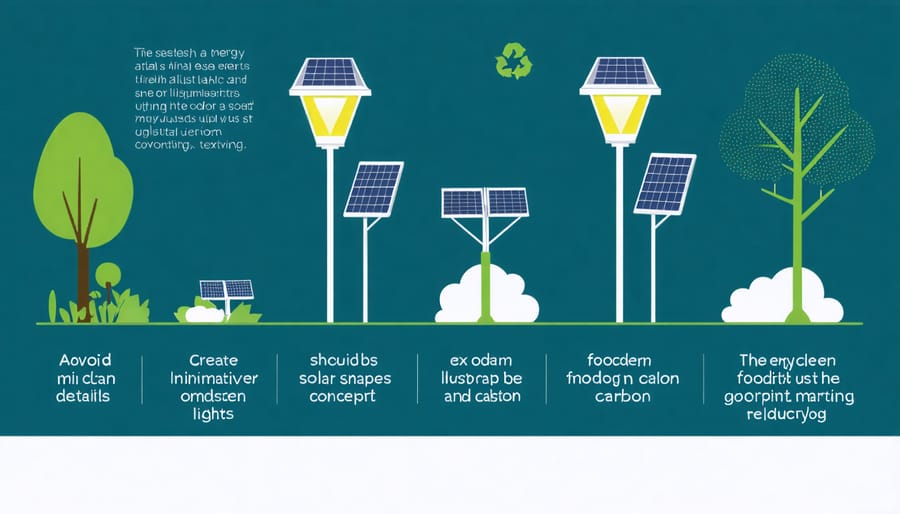Solar Garden Lights That Transform Your Outdoor Space (Without Complex Wiring)

Transform your outdoor spaces with solar-powered accent lighting – the perfect blend of sustainable elegance and practical illumination. These innovative fixtures harness daylight to create enchanting evening atmospheres while eliminating energy costs and complex wiring requirements. Modern solar outdoor lighting ideas now feature advanced photovoltaic cells and efficient LED technology, delivering reliable performance even during Europe’s varying seasonal conditions. From illuminating garden pathways to highlighting architectural features, these eco-friendly lighting solutions offer sophisticated ambiance without compromising environmental responsibility. With minimal maintenance requirements and automatic dusk-to-dawn operation, solar accent lighting represents a smart investment in both property aesthetics and sustainable living. The latest generation of fixtures combines weather-resistant construction with elegant designs, ensuring year-round reliability while complementing any outdoor décor style.
How Solar Garden Accent Lights Actually Work
The Solar Power Collection System
At the heart of solar-powered accent lighting lies an efficient collection system that transforms sunlight into usable energy. The primary component is a photovoltaic panel, typically measuring 10-30 square centimetres for residential accent lights. These compact panels utilise monocrystalline or polycrystalline silicon cells, offering optimal energy conversion rates between 15-22%.
During daylight hours, the solar panels capture photons and convert them into electrical energy through the photovoltaic effect. This energy passes through a charge controller, which regulates the power flow and prevents overcharging. The electricity is then stored in built-in rechargeable batteries, commonly lithium-ion or NiMH types, which power the LED lights during evening hours.
Modern solar collection systems incorporate advanced features like automatic light sensors and intelligent power management. These innovations ensure optimal charging even in varying European weather conditions, from the bright Mediterranean summers to the shorter winter days of Northern Europe. The systems are designed to be weather-resistant, with protective glass covers and durable frames that withstand diverse climate conditions while maintaining collection efficiency.

Battery Storage and LED Technology
Modern solar accent lights combine advanced battery storage technology with energy-efficient LED illumination to deliver reliable performance. Most quality systems utilize lithium-ion or LiFePO4 batteries, which offer superior charge retention and longer lifecycles compared to traditional options. These batteries efficiently store energy during daylight hours, ensuring consistent illumination throughout the night.
LED technology plays a crucial role in maintaining optimal brightness levels while minimizing energy consumption. Modern LEDs can last up to 50,000 hours while consuming just a fraction of the energy required by conventional bulbs. This efficiency allows for smaller battery units and solar panels, resulting in more compact and aesthetically pleasing designs.
The latest solar accent lights feature intelligent charge controllers that protect batteries from overcharging and deep discharge, significantly extending their operational lifespan. Many models also include automatic brightness adjustment capabilities, which help conserve energy during longer winter nights and ensure consistent performance year-round. This combination of advanced storage and LED technology makes modern solar accent lighting a reliable and sustainable choice for outdoor illumination.
Smart Placement for Maximum Impact
Optimal Solar Panel Positioning
To maximise the performance of your solar-powered accent lighting, proper panel positioning is crucial. The optimal angle for solar panels in Europe typically ranges between 30-45 degrees, depending on your specific latitude. Southern-facing installations receive the most direct sunlight throughout the day, making this orientation ideal for most European locations.
Consider seasonal variations when positioning your panels. While a fixed angle of 35 degrees works well year-round for most central European locations, adjustable mounting systems allow you to optimise exposure by increasing the angle in winter (up to 60 degrees) and decreasing it in summer (down to 25 degrees).
Avoid shade from buildings, trees, or other structures, as even partial shading can significantly reduce energy collection efficiency. For optimal performance, ensure your panels receive unobstructed sunlight during peak hours (10:00-16:00). If complete shade avoidance isn’t possible, consider using multiple smaller panels in different locations rather than one larger unit.
Remember to keep your panels accessible for regular cleaning and maintenance. In snowy regions, a steeper angle helps prevent snow accumulation, while in areas with frequent rainfall, an angle of at least 15 degrees ensures proper water runoff and self-cleaning.
Regular monitoring of your panel’s performance can help identify if adjustments are needed to maintain optimal efficiency throughout the year.
Creating Lighting Zones
Creating effective lighting zones in your garden requires careful planning and strategic placement of solar-powered accent lights. Begin by identifying key focal points such as pathways, flower beds, water features, and architectural elements. These areas will serve as primary zones for your lighting design.
For pathways and walkways, position lights at regular intervals of 1.5 to 2 metres apart to ensure consistent illumination without creating harsh spotlighting effects. When highlighting plants and shrubs, place lights at varying distances and angles to create depth and shadow play, typically 30-50 centimetres from the base of larger specimens.
Consider creating layers of light by combining different types of solar accent lights. Use stake lights for bordering garden beds, spotlights for trees and tall shrubs, and decorative lanterns for seating areas. This multi-level approach adds visual interest and practical functionality to your outdoor space.
Remember to account for seasonal changes when planning your zones. Position solar panels where they receive maximum sunlight exposure throughout the year, considering tree canopy growth and shadow patterns. For areas requiring additional illumination during winter months, cluster multiple lights together or opt for models with larger solar panels.
To enhance energy efficiency, group lights according to usage patterns. Place brighter lights in high-traffic areas while using softer illumination for purely decorative zones. This zoning strategy ensures optimal light distribution while maintaining the aesthetic appeal of your garden.

Maintenance and Longevity
Seasonal Care Tips
To maintain optimal performance of your solar-powered accent lighting throughout the year, adjust your maintenance routine according to seasonal conditions. During spring, clean the solar panels thoroughly to remove pollen and winter residue, and check that winter hasn’t displaced any fixtures. Trim back any new plant growth that might shade the solar collectors.
Summer offers peak charging conditions, but inspect panels monthly for dust and debris to maximise light absorption. Position adjustable lights to account for longer daylight hours and changing sun angles. Consider reducing operating hours to preserve battery life during extended bright periods.
Autumn requires more frequent cleaning as falling leaves can obstruct solar panels. Adjust timing settings to accommodate shorter days, and check that fixtures are securely anchored before winter storms arrive. During winter, clear snow from panels promptly and periodically clean off frost accumulation. Consider repositioning lights to capture maximum available sunlight during shorter days.
For areas with severe weather, consider temporarily storing portable accent lights indoors during extreme conditions to protect their components and extend their lifespan.
Troubleshooting Common Issues
When encountering common solar light issues, most problems can be resolved with simple troubleshooting steps. If your lights aren’t performing optimally, first ensure the solar panels are free from dirt, leaves, or debris that might block sunlight absorption. Clean them gently with a soft, damp cloth and mild soap if necessary.
Poor battery performance often results from inadequate charging. Verify that your lights receive sufficient direct sunlight during the day, ideally 6-8 hours. Consider repositioning fixtures if they’re in heavily shaded areas. For lights that won’t illuminate, check if the batteries are properly inserted and replace them if they’re more than two years old.
Moisture infiltration can cause electrical issues. Inspect seals and gaskets regularly, ensuring they’re intact and properly seated. If water has entered the fixture, carefully dry the components and tighten any loose connections. During winter, snow accumulation on panels can significantly reduce charging efficiency – brush off snow regularly and consider adjusting the panel angle for optimal exposure.
For persistent problems, consult your product manual or contact the manufacturer’s support team for specific guidance.

Environmental Impact and Cost Benefits
Solar-powered accent lighting represents a significant step towards sustainable outdoor illumination, offering both environmental advantages and compelling economic benefits. By harnessing solar energy, these lighting systems dramatically reduce carbon emissions compared to conventional electric lighting solutions. A typical solar accent light can prevent approximately 12 kg of CO2 emissions annually when replacing a traditional electric equivalent.
The financial benefits become evident through substantial energy cost savings. While the initial investment might be slightly higher than conventional lighting, solar-powered accent lights typically pay for themselves within 12-18 months through eliminated electricity costs. With an average lifespan of 8-10 years for quality solar lighting systems, homeowners can expect significant long-term savings on their energy bills.
Moreover, these systems contribute to reducing grid dependency and energy infrastructure strain, particularly during peak evening hours when accent lighting is most needed. The environmental impact extends beyond energy savings, as solar-powered systems eliminate the need for underground wiring, reducing soil disruption and preserving garden ecosystems.
Maintenance costs are notably lower compared to traditional lighting systems, as there’s no need for regular electrical maintenance or wire replacement. The LED bulbs commonly used in solar accent lighting are highly efficient and can last up to 50,000 hours, further reducing replacement costs and material waste.
For European homeowners, solar accent lighting aligns perfectly with EU sustainability goals and often qualifies for local green energy incentives. This environmentally conscious choice not only enhances property aesthetics but also demonstrates a commitment to sustainable living while providing reliable, cost-effective illumination for years to come.
Solar-powered accent lighting represents a brilliant fusion of aesthetic appeal and environmental responsibility in modern garden design. By harnessing clean solar energy, these innovative lighting solutions offer European homeowners a sustainable way to illuminate their outdoor spaces while reducing energy costs and carbon footprint. The combination of sophisticated technology, minimal maintenance requirements, and seamless integration into existing landscapes makes solar accent lighting an increasingly popular choice across Europe. As we move towards a more sustainable future, embracing solar-powered garden lighting solutions not only enhances the beauty of our outdoor spaces but also contributes to a greener planet. Consider making the switch to solar accent lighting today – it’s an investment in both your garden’s ambiance and our collective environmental future.
Leave a Reply